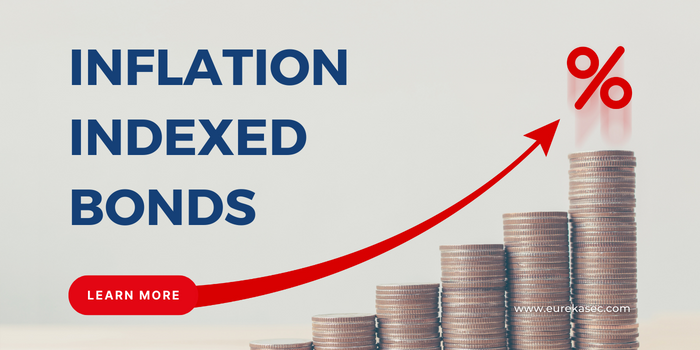
When inflation hits the economy, it is hard to find anything with a yield that can keep up with the soaring consumer prices. Even if the rate of inflation is comparatively low, it can dampen fixed income investments. This reduces the people’s purchasing power and cuts their real returns over a period of time. However, Inflation Indexed Bonds are the kind of investment that can help you hedge against inflation risk because the value of these bonds increases during periods of inflation.
What are Inflation Indexed Bonds?
Inflation Indexed Bonds are bonds that have their capital appreciation linked to inflation rates. The Inflation Indexed Securities guarantee a higher rate of return than the inflation rate if held till maturity. As an investor, if you are seeking real, safe and positive returns linked to minimal risk, then investing in Inflation-Linked Bonds is a great decision.
How Does Inflation Indexed Securities Work?
Inflation Indexed Bonds refer to a market index that assesses inflation, such as CPI. As there is a rise or a fall in the index, the bond’s capital value gets adjusted accordingly. This changes the amount you earn with every coupon payment. Inflation Indexed Securities offer inflation protection to both the principal and interest amounts.
As the inflation and capital value of Inflation Linked Bonds are directly proportional, inflation cause the capital value of the bonds to increase, and the actual return is better than the interest initially promised. However, when deflation happens, the capital value of the bonds does not decrease but the interest rate reduces, protecting the face value of your initial investment.
For example, If you have a portfolio that returns 9% and the inflation rate is 3%, then your real returns are about 6%.
Pros of Investing in Inflation Indexed Bonds
Even though inflation is not good for the profitability of most the fixed income investments. As inflation often results in interest rate hike up, an inflation-indexed security guarantees a real return. Here are some benefits of Inflation Indexed Bonds have been listed below for your clarity.
Fixed Long-Term Yield: Inflation Indexed Bonds provide investors with fixed and long-term returns. If you are looking for stability in a fixed-income investment but are concerned about inflation impact, then Inflation Linked Bonds are the right investment for you.
Portfolio Diversification: The return on Inflation Indexed Bonds has absolutely no correlation to stock market fluctuations. Hence they offer a hedge against any inflation in the economy and a very valuable diversification to your investment portfolio.
Inflation Hedge: Inflation Linked Securities are designed in a way that they do not have any inflation risk. This means in contrast to conventional bonds that lose value in real terms when an economy faces an inflation rise, Inflation Linked Bonds are protected against rising prices. In fact, the rate of interest on these bonds grows almost at the same rate as the inflation rate in the economy. This way, your savings will not lose buying power.
Low Risk: Inflation Indexed Bonds are government bonds aided by the Government of India. As an investor, you get to earn on time and assured returns. At the end of the tenure, you get back your principal amount along with the real return amounts. Hence if you are looking to add a low cost and low-risk investment
Cons of Investing in Inflation Indexed Bonds
While there are many valuable benefits of investing in Inflation Indexed Bonds, there are quite a few cons that you as an investor must know about. Some of them have been listed below for your clarity.
Phantom Income: Unrealised gain on investments that are subject to current taxes prevailing is called phantom income. This means that the money you earn but have not actually received yet. When CPI increases, then the value of the Inflation Indexed Bonds increases, this is when phantom income can occur.
Lower Earning Potential Than Other Instruments: Inflation Indexed Securities, when compared to stocks, have a lower earning potential. This is because they offer a fixed rate of return. While investment in the stock market has the potential to earn higher returns, Inflation Indexed bonds earn a fixed rate of return that only increases depending on the inflation rate increase in the economy.
Early Withdrawal Penalty: Inflation Indexed Bonds come with an early withdrawal penalty. If you withdraw funds after one year of investment but before a tenure of five years, then you will lose out on the last three months of interest earned.
One Year Lockup: Inflation Indexed Securities come with a one year lock-up period. This means you cannot withdraw your money back within the first year of the investment. Hence if you want your funds anytime soon, you mustn’t invest in these securities.
When we look at both the pros and cons of Inflation Linked Bonds the advantages of investing in Inflation Indexed Bonds outweigh its disadvantages. They are one of the most popular and trusted government bonds to hedge against inflation. The eroding outcome that inflation can have on returns is a solid motivating reason behind the popularity of these bonds.
To know more about Inflation Indexed Bonds, such as how to invest in Inflation Linked Securities, their features, the rate of interest that can be earned on these bonds, and applicable tax implications, you can Connect With Team Eureka and leverage end-to-end investment and financial asset management assistance based on your financial goals and investment strategy.







